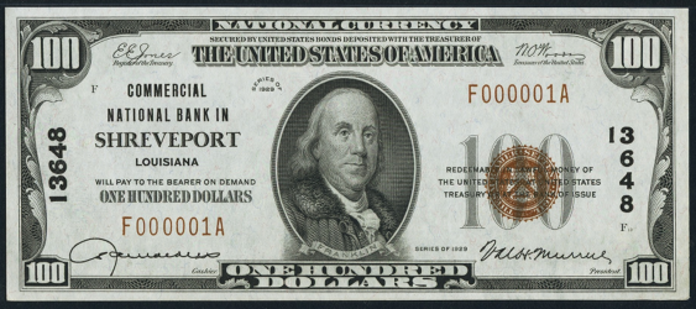One Hundred Dollar Notes › Nationals › 1929 One Hundred Dollar National Bank Notes › Minnesota Charters › 1929 $100 Brandon Minnesota First National Bank
Get Value Now
| Item | Info |
|---|---|
| Series | 1929 |
| Charter | #10862 First National Bank of Brandon, Minnesota |
| Year Chartered | 1916, 122 Banks Chartered |
| City Info | Brandon is a city in Douglas County, Minnesota, United States. The population was 489 at the 2010 census. The village of Brandon was incorporated on November 22, 1881. The current town site was laid out when the railroad was being built in August 1879. The town was called Chippewa when at its previous location which was two miles north of the present day site. Brandon was named in honor of Brandon, Vermont, the birthplace of Stephen A. Douglas. Source: Wikipedia |
| Similar Cities | If your note doesn't match try: 1. Brandon, Vermont - First National Bank 2. Brandon, Vermont - Brandon National Bank 3. Brandon, Vermont - Brandon National Bank |
| Seal Varieties | Small Brown |
| See Also | If your note doesn't match try: 1. 1929 $100 Federal Reserve Bank Note 2. 1928 $100 Federal Reserve Note 3. 1928A $100 Federal Reserve Note 4. 1934 $100 Federal Reserve Note 5. 1934A $100 Federal Reserve Note 6. 1934B $100 Federal Reserve Note |
| Other Info | 1. Value depends on notes known for charter, condition and market demand. |
| Neat Fact | Portrait of Franklin. Note appearance similar to 1929 Federal Reserve Bank Notes. |
No Obligations Offers and Appraisals
Please submit a good photo or scan. It will be identified and evaluated. Understand there may be subtle differences between the image you see above and your note. Signatures, design, markings and note condition will determine the offer price. Notes in Uncirculated or better condition receive the best offers.
Appraisals can be estimated for wholesale and retail prices. Wholesale is what dealers typically pay. Retail is what a collector might pay. Retail is slightly higher in most cases.
Please visit this page for USA Paper Money Reference. Do not treat this page as a reference guide, it is for appraisal and acquisition purposes only.
